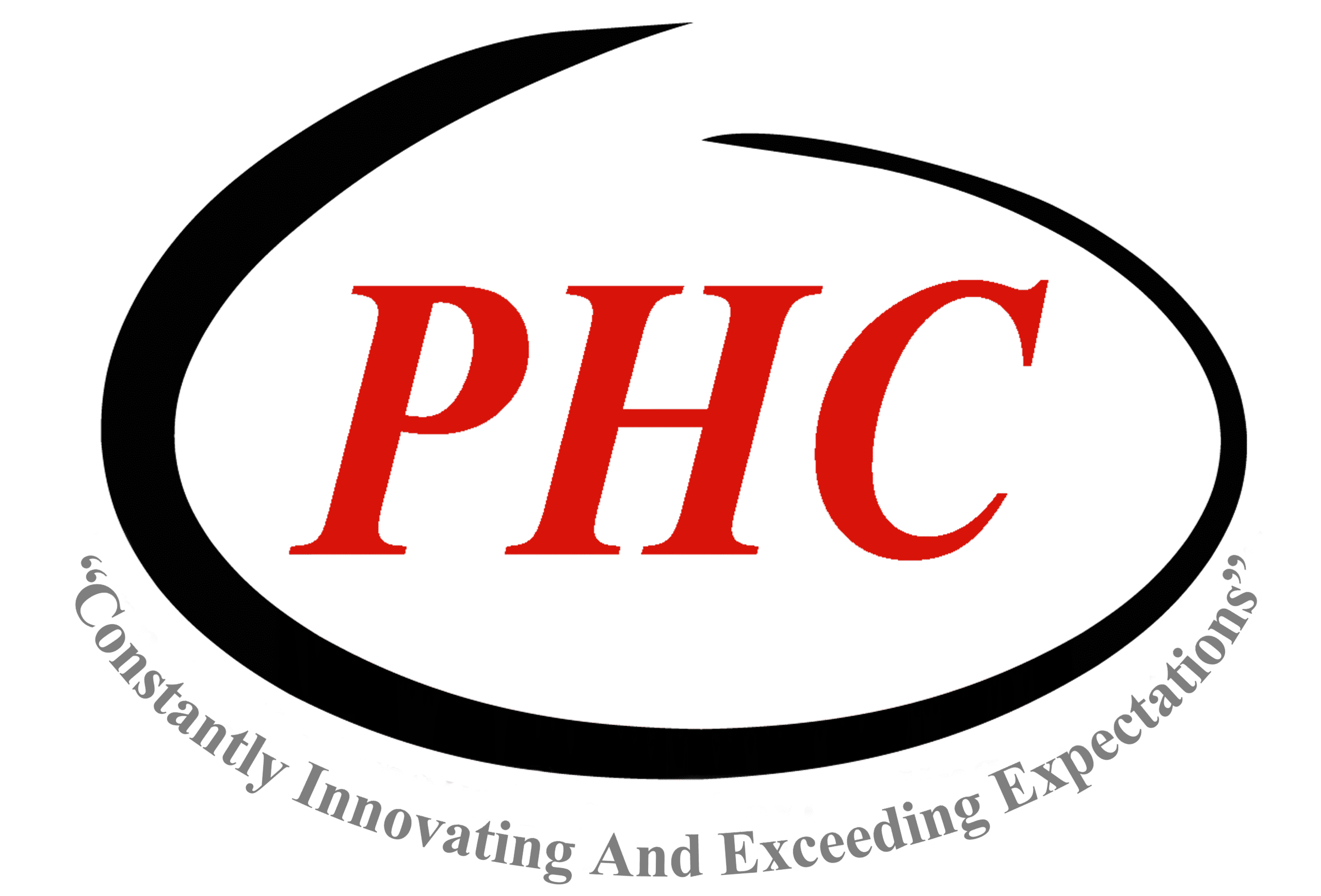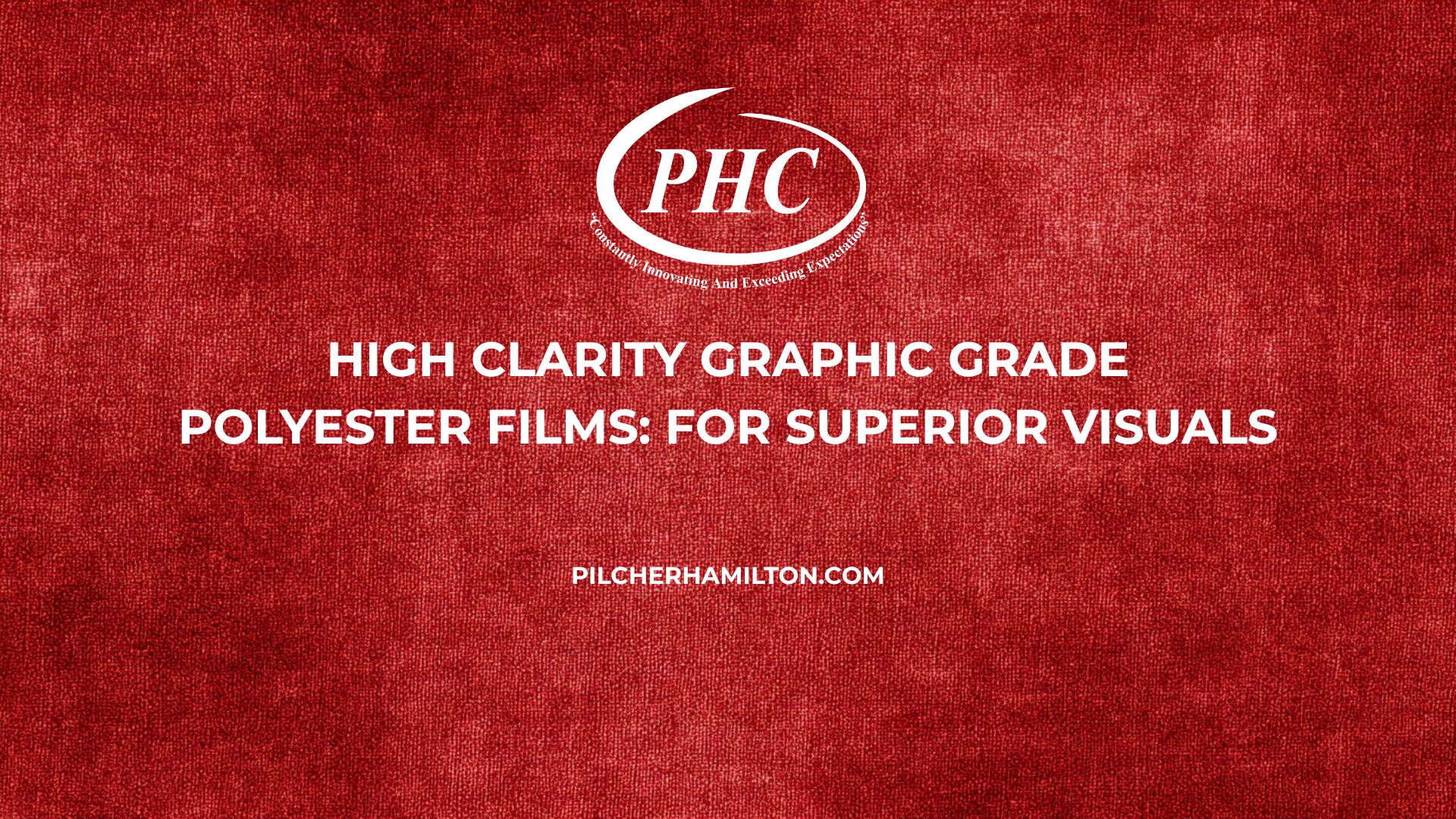When print quality, dimensional stability, and optical purity all matter, high clarity graphic grade polyester films (PET/BOPET) are the default choice for demanding converters and brand owners. From premium labels and decals to backlit retail signage and appliance overlays, the right polyester film delivers glass-like transparency, tight gauge control, and reliable ink adhesion. For engineers and buyers searching for polyester near me, this guide explains how to specify the exact PET needed to achieve vibrant graphics, clean die-cuts, and durable adhesion—without sacrificing line speed or yield.
At Pilcher Hamilton Corporation (PHC), we help you match the correct BOPET grade to your process—balancing dyne levels, COF, gauge, and surface chemistry—so printed graphics look crisp on day one and stay that way in the field.
Key Takeaways
- Optical performance: Graphic-grade PET combines high light transmission (often >88–90%), low haze, and high gloss for sharp, saturated prints.
- Surface readiness: Corona-treated surfaces at ≥38–44 dynes/cm improve wetting, ink anchorage, and lamination strength.
- Process stability: BOPET’s dimensional stability supports precise registration for screen, flexo, gravure, inkjet, and UV workflows.
- Convert-to-fit: PHC provides slitting, sheeting, winding, toll converting, and coating to your print line realities.
- End-use versatility: From appliance graphics and POP displays to protective overlays and industrial labels, there’s a polyester film for every graphic demand.
Why High Clarity PET is the Visual Benchmark
Optical Properties that Make Graphics “Pop”
Graphic-grade polyester film is engineered for extremely low haze, high total light transmission, and consistent gloss. These attributes ensure fine text remains legible, halftones hold detail, and brand colors remain faithful across runs. PET’s refractive index and smooth surface also support mirror-like clarity for protective covers and window graphics.
Mechanical Strength and Flatness
BOPET’s high tensile modulus and low shrink deliver reliable registration and die-cutting accuracy, reducing scrap on tight-tolerance jobs (e.g., appliance control panels, membrane switches). Flatness helps prevent cockling during high-dpi digital print passes, improving ink laydown uniformity.
Thermal and Chemical Endurance
With a melting point near 250 °C and excellent thermal stability, PET films can endure lamination nip temperatures and post-processing without warping. Properly treated or coated surfaces resist common cleaning agents, hand oils, and abrasion encountered in real-world use.
Explore PHC’s dedicated High-Clarity Graphic Grades for detailed options and availability:
Graphic-grade PET film lineup
Surface Treatment: The Foundation of Ink & Lamination Performance
Corona Treatment (CT)
For most print and laminate workflows, aim for ≥40 dynes/cm measured prior to converting. This target supports strong ink anchorage and adhesive wet-out for over-lamination and mounting. If your inks are energy-sensitive or you’re printing heavy solids, specify the high end of the range (42–44 dynes/cm). Learn more about PHC’s surface-prep options:
Functional Coatings (When Needed)
- Acrylic coatings can enhance chemical resistance, slip, and printability for solvent or UV systems. See Acrylic-coated PET.
- Silicone-coated release films are ideal when your graphic stack includes pressure-sensitive adhesives and you need controlled release; see Silicone-coated release films and Adhesive silicone-coated base films.
Graphic & Display Applications that Benefit from BOPET
Premium Labels & Decals
High clarity PET maintains color fidelity and fine-line detail. Typical gauges are 50–125 µm (2–5 mil) for durable labels that resist tearing during application and use.
Backlit & Edgelit Signage
Low haze and high transmission are critical for lightbox and edgelit displays. PET’s stability preserves dot patterns and diffuser films in multi-layer constructions.
Appliance Overlays & Control Panels
Dimensional stability and abrasion resistance keep legends readable. Over-lamination with hardcoat layers can add scratch resistance while preserving clarity.
Protective Windows & Device Covers
Clear polyester films serve as sacrificial layers during assembly or retail display. Even after removal, they must peel cleanly—requiring the right surface chemistry and COF.
See broader use cases for polyester packaging films and industrial applications in our All Products and All Services hubs.
Specifying the Right Film: Gauges, COF, and Barrier
Graphic applications rarely hinge on high gas barrier, but optical cleanliness and handling do. Use the parameters below as a starting point, then align with your press and post-processing steps.
Typical Specification Targets for Graphic-Grade PET
| Attribute | Recommended Range | Why It Matters |
| Gauge | 50–188 µm (2–7.5 mil) | Thicker for rigidity/overlay; thinner for conformability |
| Haze | ≤1.0–1.5% | Keeps whites bright and blacks deep |
| Light Transmission | ≥88–90% | Maximizes vibrancy and backlight efficiency |
| Gloss (60°) | 90–120 GU | Enhances perceived print quality |
| Dyne Level (CT) | 38–44 dynes/cm | Ink anchorage & laminate bond strength |
| COF (Static/Kinetic) | 0.30–0.55 | Feed reliability without scuffing |
| MD/TD Shrink (150 °C, 30 min) | ≤1.5–2.0% | Registration stability during curing/lamination |
Note: Where higher scratch or chemical resistance is required, specify coated options or plan for a hardcoat over-lam.
Process Compatibility: Printing, Lamination, Die-Cutting
Printing
Flexo, screen, gravure, UV inkjet, and aqueous inkjet platforms all run effectively on the right PET surface. For UV systems, verify that post-cure heat has minimal effect on registration. For aqueous inkjet, ensure the receptive layer or corona treatment matches your ink set.
Lamination
PET bonds well to PSA adhesives, polyolefin over-lam films, and hardcoat layers when dyne levels are maintained. If bond strength is inconsistent, confirm surface energy at the point of lamination—not just at receipt—since treatment can decay over time.
Die-Cutting & Kiss-Cutting
Dimensional stability and toughness yield crisp cuts with fewer angel hairs. Optimize anvil pressure and die angle to avoid edge bloom on glossy surfaces.
Options Matrix: Selecting PET for Your Graphic Stack
| Use Case | Preferred Surface | Typical Gauge | Notes |
| Outdoor decals | Corona-treated + Acrylic-coated | 100–188 µm | UV durability, strong ink anchorage |
| Appliance overlays | High-clarity CT | 125–188 µm | Low shrink, high rigidity |
| Backlit signage | Very low haze CT | 100–175 µm | Maximize light transmission |
| Protective windows | CT, controlled COF | 50–100 µm | Clean removal, scratch-resistant laminate |
| Retail labels | CT or ink-receptive | 50–125 µm | Die-cut friendly, fast application |
Converting with PHC: Precision In, Precision Out
Printing excellence depends on input roll quality. PHC’s converting services keep your lines running smoothly:
- Slitting: Tight width tolerances, clean edges, consistent roll builds.
- Sheeting: Flat, square sheets for screen or offset workflows.
- Winding: Controlled tension to protect optical surfaces.
- Toll Converting: Your supplied rolls, our precision.
- Film Specs & Data: Reference performance ranges and technical notes.
Buyer’s Checklist: Graphic-Grade PET (Copy-Ready)
- End-Use & Environment: Indoor/outdoor? Exposure to cleaners, UV, abrasion?
- Gauge Target: 50–188 µm (2–7.5 mil) based on rigidity vs. conformability.
- Optical Requirements: Haze ≤1–1.5%; transmission ≥88–90%; gloss 90–120 GU.
- Surface Energy: Specify arrival dyne ≥40, with verification prior to printing/laminating.
- COF Window: 0.30–0.55 consistent with your feed system and stacking method.
- Print Method: Screen, UV inkjet, aqueous, flexo, gravure—match surface/primer accordingly.
- Lamination Stack: Over-lam (polyolefin or hardcoat), PSA, release liner compatibility.
- Die-Cutting Tolerance: Registration, minimum radius, expected part geometry.
- Handling & Protection: Interleaf, core size, roll OD, packaging to protect optical face.
- Documentation: Access technical datasheets and spec ranges before press time: Technical Datasheets.
FAQ
Q1: What differentiates “graphic grade” PET from standard packaging PET?
Graphic grades emphasize ultra-low haze, high gloss, and consistent dyne levels for print adhesion, whereas polyester packaging films focus more on barrier and sealability.
Q2: What dyne level should I specify for reliable print anchorage?
Most converters see best results at ≥40 dynes/cm; for heavy ink coverage or challenging inks, request 42–44 dynes/cm at the press.
Q3: Can high clarity PET handle outdoor exposure?
Yes—when paired with UV-resistant inks and, when needed, acrylic or hardcoat over-laminates. PET’s dimensional stability helps maintain registration and readability.
Q4: What gauges work best for appliance overlays and control panels?
Common choices are 125–188 µm (5–7.5 mil) to achieve stiffness, scratch resistance (with over-lam), and clean die-cuts.
Q5: Where can I source polyester near me for visual graphics applications?
PHC supplies nationwide from our Greer facility, supporting fast delivery of high clarity graphic grade polyester films to U.S. converters and OEMs.
Specify Clarity. Protect Color. Print with Confidence.
If your next label, overlay, or retail display depends on high clarity graphic grade polyester films, let PHC dial in the exact gauge, dyne level, and surface finish to match your press and lamination stack. Teams searching for polyester near me can partner with a U.S. converter who understands line reality and delivers at production speed.
Start the conversation via Contact PHC or explore our locations.
Pilcher Hamilton Corporation
850 South Buncombe Road
Greer – South carolina
🔗 Contact PHC | Locations

